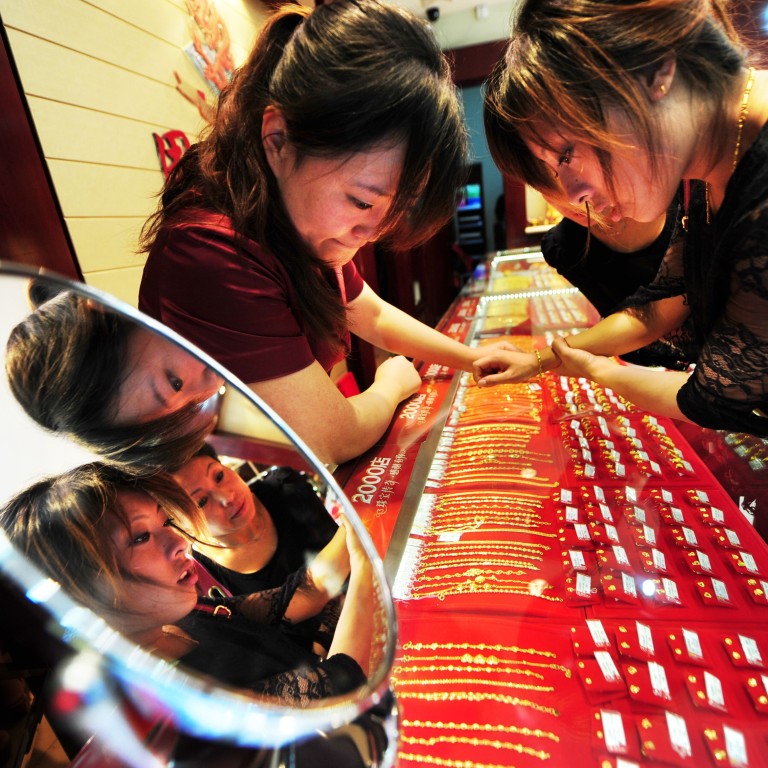
‘Nice but a bit dull’ – why China’s growing ranks of affluent, independent women don’t want their men to buy them jewellery
- The new trend for women to treat themselves to necklaces and rings has changed the jewellery landscape in China
- Local and global brands have responded to the shift in demand by launching new ranges aimed at the successful female consumer
Millions of besotted men around the world will shower their partners with gifts today, many opting for jewellery to symbolise their undying love on Valentine’s Day.
But shiny new necklaces and earrings may not be the best way for men to woo their other halves in China, where a growing number of affluent, independent women say they would rather buy their own.
Crystal Zhang, 32, said her boyfriend has tended to choose classic designs that are a bit on the boring side when buying her items of jewellery.
“They are nice but a bit dull. The ones I pick for myself are more bold and playful, I feel more fun when I’m wearing them,” said Zhang, a business development manager based in Shanghai.
“For me, jewellery is not just a display of wealth, but a way to reflect my personality and identity to others.” She said she spent 8,000 yuan (about US$1,180) on jewellery for herself last year.
The rising tendency of Chinese women to flex their new-found spending power on items that reflect personal achievement has been a gold mine for high-end jewellers, who have been quick to adapt.
They have found that appealing to the modern female shopper has more to do with how women view themselves than the couples’ gift-giving tradition prevalent among Asian cultures.
“Working women use jewellery to demonstrate personal style. It’s an important indicator of their wealth and income and serves as a symbol of their status at work, at home and among other social settings,” said Zhenzhen Liu, director of global corporate marketing at Platinum Guild International (PGI).
“Marketing [of jewellery] in China nowadays focuses on young women who are looking for self-pampering supported by their financial power, particularly to mark personal milestones.
“Women see diamonds and platinum as things to go out and get for themselves.”
According to 2016 research by PGI, 37 per cent of women in China bought jewellery for themselves, while just 30 per cent said they had received jewellery as a gift from their partners.
And a report by global diamond company DeBeers Group last year found more and more Chinese people had been buying their own jewellery. In fact, “self-purchases” accounted for about a third of all diamond pieces acquired, in terms of both numbers and value, the survey found.
“The phenomenon of women buying jewellery for themselves has been one of the most influential industry mega trends of recent times,” said Kurt Zbinden, vice-president operations Asia-Pacific of Swarovski Gemstones Business. “It has effects on both the design and marketing and has encouraged the rise of female designer-jewellers, who make fine jewellery relevant again to this increasing consumer group.”

Jewellers, both domestic and international, have responded to the shifting consumer profile with an explosion of playful collections geared towards women, often available at slightly lower prices. Despite their increasing professional success, Chinese women are still on average paid far less than their male counterparts.

“Women are increasingly becoming more independent and empowered. Therefore, it is important for luxury brands like us to communicate equally to both men and women in our campaigns,” said Matthieu Pougin, managing director Asia-Pacific at Piaget, the luxury Swiss jeweller.
The thinking is that women like to mix and match and buy a range of styles to accessorise their outfits for different occasions.
With this in mind, Piaget has launched a range of watches with interchangeable alligator straps it says reflects the growing variety of roles that women play in the society today.
Hong Kong-listed Chow Tai Fook Jewellery has been capitalising on the trend by transforming its business into a multi-brand company.
For example, Hearts on Fire, an American premium diamond brand which the jeweller acquired in 2014, targets sophisticated women.
In February last year, Chow Tai Fook collaborated with PGI to launch the G&W collection, which has been well received by young female professionals in China, with pieces starting at US$150.
The collection is made of platinum, a material known for its high durability and resistance to wear, and created with the increasingly active lifestyles of Chinese women in mind.

